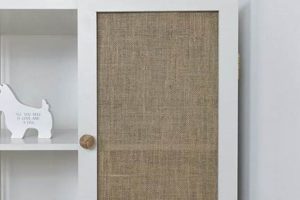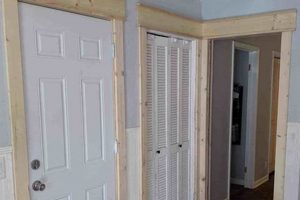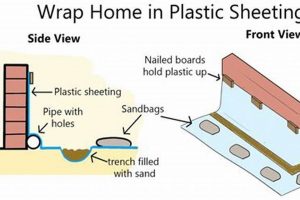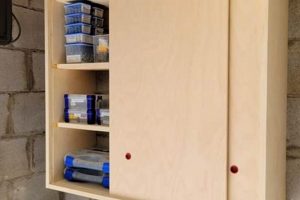Entrance coverings constructed by individuals offer a customized and cost-effective alternative to commercially manufactured options. These handcrafted floor coverings provide a means of personalization, allowing for unique designs and tailored dimensions. An example would be a woven mat created from repurposed fabric scraps, designed to fit a specific entryway configuration.
The creation of personalized entryway textiles presents several advantages. It reduces expenditure, promotes resourcefulness through material reuse, and allows for the expression of individual style. Historically, the practice reflects a tradition of domestic craft and self-sufficiency, evolving with available materials and aesthetic preferences.
This exploration will delve into various methods of creating these customized entrance pieces, examining materials, techniques, and design considerations for producing durable and aesthetically pleasing floor coverings.
Tips for Creating Personalized Entrance Textiles
Successful fabrication of individualized entryway floor coverings requires careful consideration of material selection, construction techniques, and design principles. The following tips offer guidance for creating durable and aesthetically pleasing entrance textiles.
Tip 1: Material Selection is Paramount: Choose materials resistant to moisture, abrasion, and UV degradation. Suitable options include durable outdoor fabrics, coir fibers, recycled rubber, or treated wood. Consider the intended placement and anticipated traffic volume when making this decision.
Tip 2: Prioritize Secure Construction: Ensure robust assembly to prevent disintegration under normal use. Sewing, gluing, or weaving techniques must create strong bonds. Reinforce edges and corners to minimize fraying or unraveling.
Tip 3: Incorporate Non-Slip Features: Integrate a non-slip backing to enhance safety and prevent movement on slick surfaces. Options include applying a rubberized coating or attaching a pre-made non-slip mat beneath the constructed textile.
Tip 4: Emphasize Ease of Cleaning: Select materials and designs that facilitate easy cleaning. Smooth surfaces are easier to wipe down, while removable components simplify more thorough cleaning procedures. Consider materials that can be hosed off or machine washed.
Tip 5: Adhere to Dimensional Accuracy: Precise measurements are crucial for proper fit. Account for any shrinkage or stretching that may occur during the construction process. Test the dimensions periodically to ensure alignment with the intended space.
Tip 6: Explore Textural Variation: The use of varied textures enhances both the aesthetic appeal and functionality. Incorporate raised elements for improved traction or utilize alternating materials for visual interest.
Tip 7: Apply Weatherproofing Treatments: For outdoor applications, apply weatherproofing treatments to protect against moisture, mildew, and UV damage. Consider sealants, waterproofing sprays, or UV-resistant coatings.
Implementing these tips will significantly improve the durability, functionality, and visual appeal of individualized entrance coverings, resulting in a long-lasting and attractive addition to any entryway.
The following sections will further explore specific design ideas and advanced construction techniques for creating unique and functional entrance textiles.
1. Material Durability
The longevity and functionality of entrance coverings are directly contingent upon the durability of the selected materials. In the context of self-constructed entrance coverings, material choice represents a foundational decision impacting the product’s resistance to wear, environmental factors, and repeated use. Premature material degradation leads to functional failure, necessitating frequent replacement and negating the cost-effectiveness of a do-it-yourself approach. For example, an entrance covering constructed from untreated natural fibers, while aesthetically appealing initially, will rapidly deteriorate when exposed to moisture and foot traffic compared to one made with recycled, treated rubber.
The selection of durable materials contributes significantly to the overall value and practicality of a handcrafted entrance covering. Resistance to abrasion, UV exposure, and water damage extends the lifespan of the product, reducing the need for frequent repairs or replacements. A covering made from a durable, mold-resistant material not only offers better performance, but also reduces potential health hazards. Consider, for example, a floor covering woven from marine-grade rope, designed to withstand continuous exposure to moisture and heavy foot traffic in a coastal environment. This provides a long lasting, reliable solution, compared to using standard rope susceptible to rapid rot and wear.
In summary, prioritizing material durability in the construction of entrance coverings ensures a functional and sustainable outcome. This initial investment in robust materials yields long-term benefits, reducing maintenance costs and enhancing the overall lifespan of the finished product. The interplay between material choice and overall durability is a crucial factor in determining the success and value of a self-constructed floor covering.
2. Construction Method
The chosen construction method directly influences the durability, aesthetic, and functionality of handcrafted entrance coverings. The means by which materials are assembled determines the structural integrity of the covering and its ability to withstand repeated use and exposure to environmental elements. A poorly executed construction method can negate the benefits of even the most durable materials, resulting in premature failure. For instance, a woven entrance covering with loose or uneven stitches will likely unravel under heavy foot traffic, irrespective of the yarn’s inherent strength.
Various construction methods are applicable, each with inherent advantages and disadvantages. Weaving provides a strong, interlocking structure, suitable for utilizing materials like fabric strips or rope. Gluing offers a simpler approach for adhering materials to a backing, but the adhesive’s durability is paramount. Sewing, particularly with reinforced stitching, can create robust seams and intricate designs. The selection of a construction method must align with the chosen materials, the intended use of the entrance covering, and the crafter’s skill level. A complex pattern requiring advanced weaving techniques may be impractical for a novice, whereas a simpler glued design might suffice for low-traffic areas. Consider the example of a rubber mulch entrance covering, where the adhesive used to bind the mulch particles must withstand outdoor conditions and constant pressure.
In conclusion, the construction method is a critical determinant of the overall success of individualized entryway floor coverings. Understanding the strengths and limitations of different construction techniques allows for informed decision-making, resulting in a long-lasting, aesthetically pleasing, and functionally effective product. Proper execution of the selected method is essential for realizing the intended design and ensuring the entrance covering can withstand the rigors of daily use. Challenges in execution can be mitigated through practice, careful material selection, and adherence to established crafting principles, ultimately linking the construction method to the broader theme of creating personalized and practical home accessories.
3. Non-Slip Safety
Non-slip safety is a paramount consideration in the design and construction of entrance coverings. The implementation of measures to prevent slippage minimizes the risk of falls and injuries, particularly in environments prone to moisture or high traffic volume. The creation of such coverings necessitates a focused approach to ensure adequate traction and stability.
- Coefficient of Friction
The coefficient of friction (COF) quantifies the degree of slip resistance between two surfaces. A higher COF indicates greater resistance to slippage. When constructing entrance coverings, materials with inherently high COF values, such as rubber or textured polymers, are preferable. Applying a coating or backing with a high COF to a less inherently slip-resistant material (e.g., coir) can enhance overall safety. For instance, the Americans with Disabilities Act (ADA) provides guidelines for accessible surfaces, including minimum COF requirements. An improperly designed floor covering with a low COF can create a significant safety hazard, especially for individuals with mobility impairments.
- Material Selection
Material selection directly impacts the slip resistance of an entrance covering. Certain materials, such as smooth, polished stone or tightly woven fabrics, inherently offer minimal traction, especially when wet. Conversely, materials like open-weave coir, textured rubber, and non-slip PVC offer enhanced grip. The choice of material must balance aesthetic considerations with functional safety requirements. Examples include using recycled rubber tires cut and arranged to create a textured surface or incorporating embedded abrasive particles within the coverings design to increase traction. Material selection should also consider long-term performance, ensuring that the non-slip properties are maintained over time despite wear and environmental exposure.
- Surface Texture and Pattern
The surface texture and pattern of entrance coverings significantly contribute to their non-slip characteristics. Raised patterns, grooves, and textured surfaces increase the contact area and create frictional resistance, reducing the likelihood of slippage. The design should facilitate water drainage to prevent the formation of slippery films. For instance, a floor covering with deep grooves can channel water away from the surface, maintaining a higher level of traction even when wet. Conversely, a smooth, flat surface provides minimal grip and becomes dangerously slippery when exposed to moisture or debris. Consideration should also be given to the size and spacing of textured elements; excessively large or widely spaced patterns may not provide sufficient traction, while overly small or dense patterns may become clogged with dirt, reducing their effectiveness.
- Backing and Adhesion
The backing material and its adhesion to the underlying floor surface are critical for preventing the entrance covering from shifting or sliding, which can lead to falls. A non-slip backing, typically made of rubber or a similar material, increases the friction between the entrance covering and the floor, providing stability. The adhesive used to secure the backing must be compatible with both the entrance covering material and the floor surface to ensure a strong and durable bond. Examples include using a pressure-sensitive adhesive that creates a high-friction bond or employing a textured rubber backing with inherent gripping properties. A poorly adhered floor covering presents a tripping hazard and negates the safety benefits of the surface material. The selection of appropriate backing and adhesion methods requires careful consideration of the floor surface type, anticipated traffic volume, and environmental conditions.
These facets highlight the multifaceted relationship between non-slip safety and constructed entrance coverings. By carefully considering these factors during design and construction, it is possible to create entrance coverings that are both aesthetically pleasing and functionally safe, reducing the risk of slip-and-fall accidents. Combining appropriate materials with effective construction techniques ensures safer home entryways.
4. Design Integration
Design integration, in the context of self-constructed entrance coverings, represents the harmonizing of aesthetic elements with functional requirements. Successful integration ensures that the entrance covering not only performs its intended purpose but also complements the surrounding architectural and decorative context. Consideration of design integration elevates a simple entryway textile into a cohesive component of the built environment.
- Architectural Style Alignment
The design of an entrance covering should reflect and enhance the existing architectural style of the building. For a contemporary structure, clean lines, geometric patterns, and minimalist color palettes may be appropriate. Conversely, a traditional or rustic building may benefit from entrance coverings incorporating natural materials, textured surfaces, and warm color tones. Failing to align the entrance covering’s design with the architectural style can create visual dissonance and detract from the overall aesthetic appeal. An example would be using a brightly colored, modern geometric design for a Victorian-era home; while functional, it would be visually jarring and out of place.
- Color Palette Harmony
The selection of colors for the entrance covering must harmonize with the existing color palette of the entryway and surrounding areas. Colors can be used to create contrast, highlight focal points, or blend seamlessly with the existing dcor. Consideration should be given to the psychological impact of colors and their ability to evoke certain emotions or moods. For instance, warm colors like reds and oranges can create a welcoming and inviting atmosphere, while cool colors like blues and greens can convey a sense of calm and tranquility. The selection of colors should also account for the anticipated dirt and staining; darker colors may be more practical in high-traffic areas. Utilizing a color wheel and understanding color theory principles can assist in creating a visually appealing and cohesive design.
- Material Consistency
The materials used in the construction of the entrance covering should be consistent with the materials found in the surrounding environment. Utilizing similar textures, patterns, or finishes can create a sense of visual unity and cohesion. For example, an entrance covering constructed from reclaimed wood can complement a building with exposed timber beams or a natural wood exterior. The selection of materials should also consider their durability and suitability for the intended use. Using materials that are aesthetically pleasing but not durable can lead to premature wear and detract from the overall design. Conversely, prioritizing durability at the expense of aesthetic considerations can result in a functional but visually unappealing product. A balanced approach is necessary to achieve optimal design integration.
- Personal Expression Infusion
While it is important to align the design of the entrance covering with the surrounding environment, the integration of personal expression allows for the creation of a unique and individualized statement. Incorporating personal motifs, patterns, or design elements can add character and charm to the entrance covering, reflecting the occupant’s personality and style. This can be achieved through the use of custom stencils, hand-painted designs, or the incorporation of meaningful symbols or imagery. However, the infusion of personal expression should be balanced with the need for visual harmony and cohesion. Overly eccentric or outlandish designs can detract from the overall aesthetic appeal and create visual clutter. Subtle and thoughtful integration of personal expression is key to creating an entrance covering that is both unique and aesthetically pleasing.
In summary, the successful design integration of self-constructed entrance coverings requires a careful consideration of architectural style, color palette, material consistency, and personal expression. By harmonizing these elements, it is possible to create entryway textiles that not only serve a functional purpose but also enhance the overall aesthetic appeal of the built environment. Examples include entryway floor coverings that incorporate themes from nature, showcase geometric abstractions, or mirror the interior design’s minimalist aesthetic. The thoughtful synthesis of these design elements elevates the entrance covering from a mere utility object to an integral component of the home’s visual identity.
5. Cleaning Ease
The ease with which an entrance covering can be cleaned directly impacts its long-term maintenance and aesthetic appeal. Constructed entrance coverings, due to their placement and function, are inherently susceptible to accumulating dirt, debris, and moisture. The inability to effectively clean an entrance covering results in a diminished appearance, potential harboring of allergens, and accelerated material degradation. A complex design using absorbent materials, for instance, presents challenges in removing embedded dirt, leading to premature wear and an unhygienic entryway. Conversely, designs employing smooth, non-absorbent materials with simple patterns facilitate effortless cleaning.
Practical implications of cleaning ease extend to material selection, construction techniques, and design considerations. Opting for materials resistant to staining and easily washable, such as recycled rubber or outdoor-grade synthetic fabrics, simplifies maintenance routines. Employing construction methods that avoid intricate crevices or tightly packed fibers prevents the accumulation of dirt. Design considerations include implementing patterns that do not trap debris and incorporating features like removable inserts or washable backings. A floor covering crafted from individual, easily replaceable tiles, for example, allows for targeted cleaning or replacement of soiled sections, prolonging the product’s overall lifespan and preserving its appearance. Consider a scenario where a mud-caked floor covering made from tightly woven natural fibers is virtually impossible to thoroughly clean, contrasting sharply with the efficiency of hosing down a simple rubber model.
In summary, integrating cleaning ease into the design and construction of do-it-yourself entrance coverings is essential for ensuring long-term functionality and aesthetic satisfaction. Prioritizing materials, construction methods, and designs that facilitate simple and effective cleaning promotes hygiene, extends the life of the covering, and minimizes maintenance efforts. The understanding of this critical relationship between design choices and practical upkeep ultimately enhances the value and utility of the handcrafted entrance piece, ensuring it remains an inviting and functional element of the home for years to come.
Frequently Asked Questions about Entrance Coverings
The following section addresses common inquiries regarding the selection, construction, and maintenance of entrance coverings, offering clarity on aspects that impact both functionality and longevity.
Question 1: What constitutes a durable material choice for entrance coverings designed for high-traffic areas?
Durable materials for entrance coverings in high-traffic areas include recycled rubber, coir (coconut fiber), and treated outdoor fabrics. These materials exhibit resistance to abrasion, moisture, and UV degradation, ensuring extended lifespan under demanding conditions.
Question 2: How does the construction method influence the longevity of entrance coverings?
The construction method dictates the structural integrity of the covering. Techniques such as weaving, gluing with durable adhesives, or reinforced stitching are preferable, preventing disintegration under normal use and environmental stress. Loose or weak construction compromises the covering’s durability, necessitating frequent repairs or replacement.
Question 3: What strategies effectively mitigate slip hazards associated with entrance coverings, particularly in wet conditions?
Strategies include incorporating a non-slip backing made of rubber or similar material, selecting materials with inherent texture or raised patterns, and ensuring proper drainage to prevent water accumulation. These features increase the coefficient of friction between the covering and the floor, reducing the likelihood of slips and falls.
Question 4: How should design integration be approached to ensure an entrance covering complements the overall aesthetic of a home?
Design integration requires considering the architectural style of the building, the existing color palette, and the materials used in the surrounding environment. The entrance covering should harmonize with these elements, creating a cohesive and visually appealing transition from the exterior to the interior.
Question 5: What cleaning practices are recommended to maintain entrance coverings and prevent the buildup of dirt and allergens?
Recommended cleaning practices include regular vacuuming, hosing down with water, and spot-treating stains with appropriate cleaning agents. The frequency of cleaning depends on the traffic volume and environmental conditions. Selecting materials and designs that facilitate easy cleaning is crucial for long-term maintenance.
Question 6: How does material selection impact the environmental sustainability of individualized entryway floor coverings?
The selection of recycled or sustainably sourced materials reduces the environmental impact of the coverings. Options such as recycled rubber, reclaimed wood, or sustainably harvested natural fibers minimize waste and promote responsible resource management. Choosing durable materials also contributes to sustainability by extending the product’s lifespan.
These questions and answers provide a comprehensive overview of key considerations for crafting entrance coverings that are durable, safe, aesthetically pleasing, and environmentally responsible.
The subsequent section will explore the legal and regulatory considerations surrounding the fabrication and sale of these textiles.
Conclusion
This exploration of self-constructed entrance coverings has addressed critical aspects ranging from material durability and construction methods to non-slip safety, design integration, and cleaning ease. The synthesis of these considerations is essential for producing durable, functional, and aesthetically pleasing “diy door mats” that effectively serve their intended purpose within a residential or commercial entryway.
Effective construction of entrance textiles represents a viable alternative to commercial offerings, fostering resourcefulness and customization. Continued adherence to best practices in material selection, construction, and maintenance will ensure the creation of safe and visually appealing entrance solutions, contributing to both the aesthetic and functional quality of the built environment.







